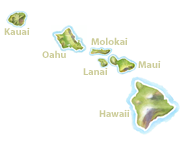Eight Major Islands

| Island | Summit | Altitude |
| Kauaʻi Oʻahu Maui Molokaʻi Lānaʻi Kaho‘olawe Hawaiʻi Island |
Kawaikini Kaʻala Haleakalā Kamakou Lānaʻihale Puʻu Moaulanui Maunakea |
5,243 4,003 10,023 4,961 3,366 1,483 13,796 |
Ni‘ihau (Population 160, Area 69 sq. miles) Privately owned island, with livestock raising as its principal industry; highly limited access by general public through helicopter landings at uninhabited sites. Legend says it was the original home of the goddess Pele.
Kauaʻi (Population 58,303, Area 552 sq. miles) The "Garden Island" offers magnificent scenery and lush vegetation, beautiful waterfalls, the spectacular Waimea Canyon, the great "hidden" valley of Kalalau, colorful tropical plants and flowers. Landmarks: Hanalei Bay, Wailua River, Nawiliwili Bay, Poʻipū Beach.
O‘ahu (Population 876,156, Area 597 sq. miles) The most populated island, where Honolulu is the Capital City, the principal port, the major airport, and business and financial center, and the educational heart of the State. O‘ahu is the military command center of the Pacific. Waikīkī is the visitor center. Landmarks: Nuʻuanu Pali, Diamond Head, Pearl Harbor.
Maui (Population 117,644, Area 727 sq. miles) The "Valley Isle" produces sugar, pineapple, cattle, horses. The 10,023-foot Haleakalā is the largest dormant volcano crater in the world. Lāhainā was Hawaiʻi''s capital before 1845, and still has some of the atmosphere of an old whaling town. Nearby are the Kāʻanapali and Wailea resort areas and golf courses. Hana and ʻĪao Valley draw many visitors.
Molokaʻi (Population 7,404, Area 260 sq. miles) The "Friendly Isle" has diversified agriculture, ranching, tourism and the world's highest sea cliffs along its northern coast. On a 13-square-mile peninsula below high cliffs is Kalaupapa, the Hansen's Disease settlement, officially called Kalawao County, a National Historical Park.
Lānaʻi (Population 3,193, Area 140 sq. miles) Hawaiʻi''s "Secluded Island." Formerly known as the "Pineapple Island," Almost the entire island was until recently a Dole Company pineapple plantation but is now phasing in tourism, and is home to two new world-class resorts.
Kaho‘olawe (Uninhabited, Area 45 sq. miles) Once used as a target by U.S. Navy and Air Force which are cleaning up unexploded shells. No one is allowed to go ashore without permission.
The island of Hawaiʻi (Population 201,513*, Area 4,028 square miles) is an island of spectacular contrasts and diversity. With all but four of the original Koppen Climate subzones, creating an ecosystem unlike any other. From the world’s tallest mountain (when measured from its base on the seafloor) to the world’s most massive mountain. 266 miles of coastline include several marine conservation districts, the 442-ft. sheer drop ʻAkaka Falls, stellar stargazing, five National Parks, botanical gardens, agricultural/aquaculture tours and much more! Landmarks: Hawaiʻi Volcanoes National Park, Kealakekua Bay, Kailua-Kona, Pololū Valley, Hilo, ʻAkaka Falls, Hulihe‘e Palace.
| Island Colors & Flowers | |
| Hawai‘i Island | Red Lehua ‘Ōhi‘a island color Red |
| Maui | Lokelani (Pink Cottage Rose) island color Pink |
| Moloka‘i | White Kukui Blossom island color Green |
| Kaho‘olawe | Hinahina (Beach Heliotrope) island color Grey |
| Lāna‘i | Kaunaoa (Yellow and Orange Air Plant) island color Orange |
| O‘ahu | ʻIlima island color Yellow |
| Kaua‘i | Mokihana (Green Berry) island color Purple |
| Ni‘ihau | Pupu Shell island color White |




